Table of contents
- Version documentalist
- Version realisation
- Detailed staff
- Electronic equipment list
- Work related information
- Useful links on Brahms
- Instructions
- Program note
Performance date: 11 juin 2022 - First performance
Documentation date: 28 septembre 2023
Version state
Valid
Validation date: 25 octobre 2023
Executions dates of this version
- 11 juin 2022, Eglise San Marco
- 15 juin 2022, Theater Haus
- 18 juin 2022, Centre Pompidou, Grande Salle
Version documentalist
- meudic (Benoit.Meudic@ircam.fr)
Version realisation
- Benoit Meudic (Computer Music Designer)
- Sylvain Cadars (Sound engineer)
- Stefano Gervasoni (Composer)
Version length
35 mnNo other version available
Detailed staff
- chœur mixte [entre 24 et 32 chanteurs] (2 soprano, 2 contralto, 2 ténor, 2 basse)
Channel details
- Number of input channel : 16
- Number of output channel : 9
Electronic equipment list
Computer Music Equipment
-
1 MacBook Pro - Apple Laptops
(Apple)
Main computer (with at least mac os 10.15.7) -
1 Live - Music Software
(Ableton)
Live 10 (not compatible with Live version 11 !!!) -
1 Digiface Dante - Sound Board
(RME)
-
1 BCF 2000 - MIDI Mixer
(Behringer)
for mixing electronics
Work related information
Premiere
- 9 juin 2020, France, Paris, Philharmonie, ManiFeste 2020
- 11 juin 2022, (version musique seule) Italie, Milan, église San Marco, Festival Milano Musica
- 15 juin 2022, Allemagne, Stuttgart, Theaterhaus
Publisher :
- Ricordi
Realisation
- Thomas Goepfer
- Benoît Meudic
Work length
- 55 mn
Useful links on Brahms
- De Tinieblas pour chœur mixte et électronique (2020), 55mn
- Stefano Gervasoni
| File | Author(s) | Comment | |
|---|---|---|---|
| Download [28,2 Mio] | Score Score | ||
| Download [718 octets] | Document electronic treatments | ||
| Download [238,2 Mio] | Video video low resolution | ||
| Download [1,8 Mio] | Document technical rider | Sylvain Cadars | |
| Download [4,1 Gio] | Patch Ableton Live Patch concert | Benoit Meudic | |
| Download [16,4 Gio] | Document Old working materials |
Instructions
1. Audio setup
The piece is for 32 singers, electronics and video (an alternative version could be for 24 singers): 8 soprani (S1..8), 8 alti (C1..8), 8 tenore (T1..8) and 8 bass (B1..8).
The score is divided into 14 parts, each part corresponding to one letter of the hebrew alphabet (aleph, bet, guimel, dalet, he, vav, zayin, jhet, tet, yod, caf, lamed, mem, nun).
The electronics consists in realtime treatments, soundfiles, video files and a click for the conductor (for some parts).
The events are trigerred sometimes by hand sometimes by a click-track.
The video files (optional) are played on a specific computer. The video sequences are triggerred by osc messages sent from the main patch and played locally with the application ‘mix16pro’.
The singers are divided into two choirs (stereo Tut1 and stereo Tut2).
Some singers are soloists and have wireless microphones.
Groups of soloists are mixed mono at the console in soloists Left (solG) and soloists Right (solD).
Some singers share a fixed microphone.
Note: depending on the venue and the number of singers, the repartition of microphones can change. If so, that should be discussed with the composer…
Audio Inputs
- 1: S5
- 2: B8
- 3: solG
- 4: solD
- 5-6: Tut1
- 7-8: stereo mix of T1 T2 T3 T4
- 9-10: stereo mix of C1 C2 C3 C4
- 11-12: stereo mix of S1 S2 S3 S4
- 13-14;: stereo mix of B1 B2 B3 B4
- 15-16: Tut2
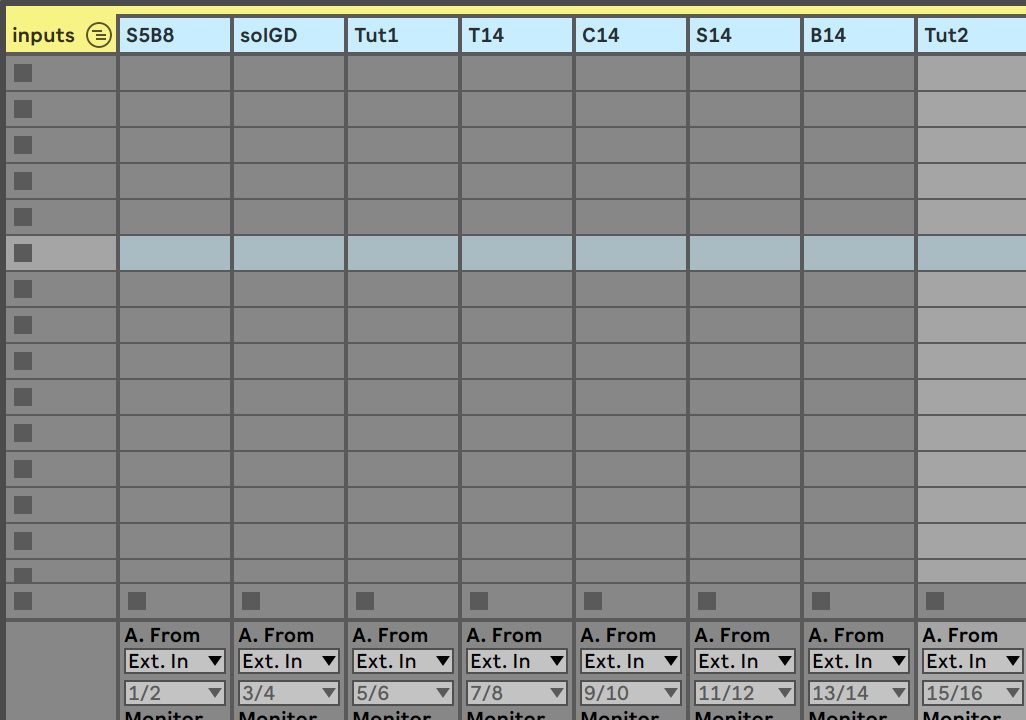
Audio Outputs
Diffusion is performed in an 8-point system plus 1 output for click-track (see layout below).
The Live section sends outputs in ascending order (1 to 8). The sound engineer routes the corresponding outputs in his console. Output 16 is for click-track.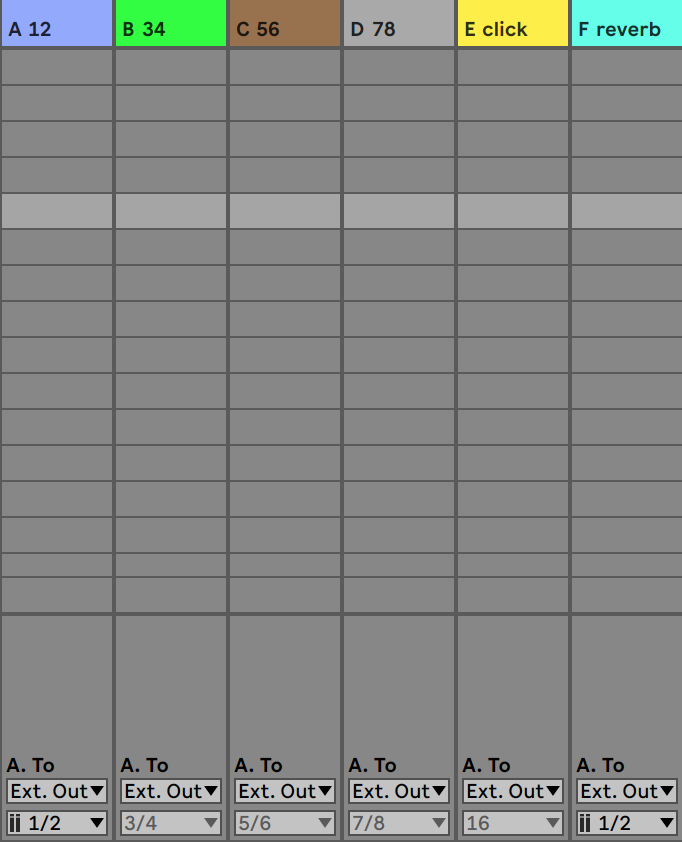
2. Loudspeaker setup
An 8-point synth is required (plus two subs), as well as click for conductor and returns.
Download and check out the technical rider with all the details.
3. Midi setup
A midi controller is required for mixing control (such as a bcf2000). See figure below for midi channel assignments.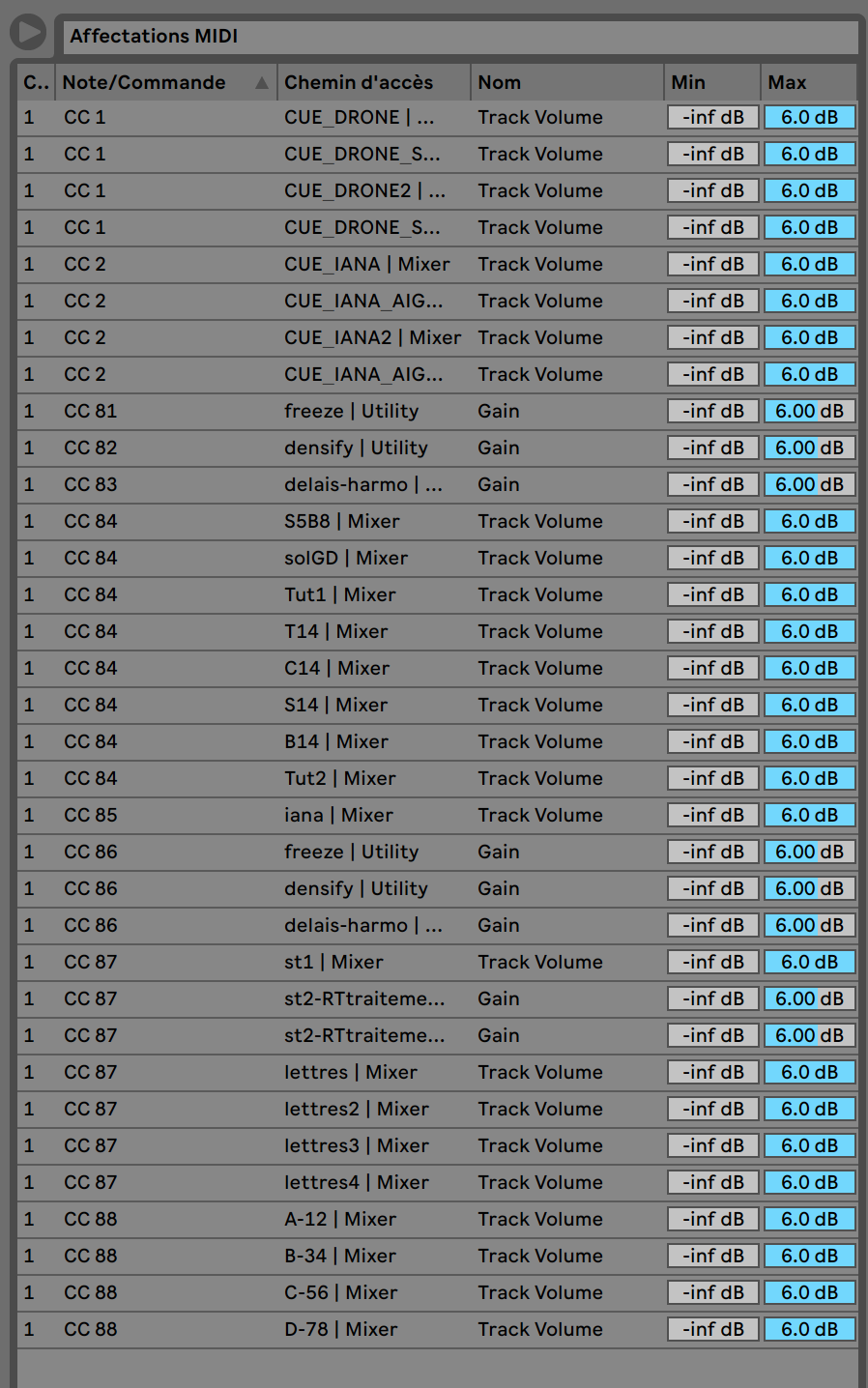
An external midi controler can also be used to trigger the scenes.
If the piece is played with a spare system, a midi interface (such as the Iconnectivity Iconnect MIDI4+) is recommended to synchronise both computers.
4. Software installation
Download all Live session content. This session requires at least Ableton Live 10 Suite 10.1.25.
Max 8 software is also required to edit Max4live devices.
4. Softwares configuration
a) Max patch configuration
Make sure you have the correct version of Max 8 in Live’s preferences.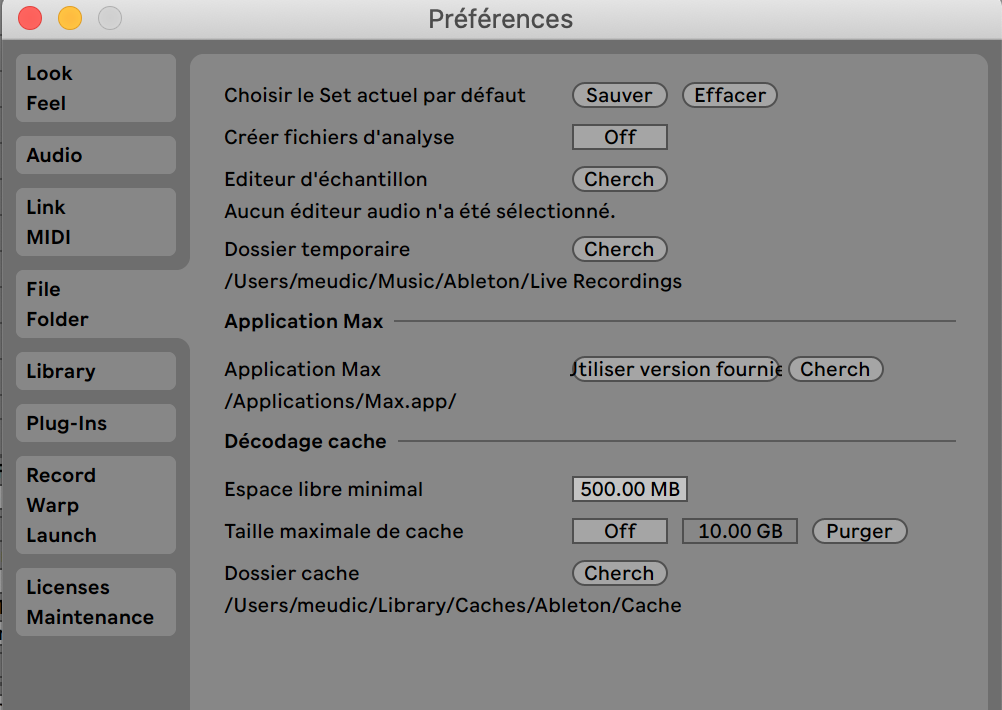
Then open the Max software, go to the options&tab and open File Preferences…
Add the /max folder (and and only this folder) to the path. Close Max and return to Live.
b) Live patch configuration
Open the patch ‘De_Tinieblas-concert17.als’ in Live.
Select your audio device in Live preferences.
DSP audiorate is 48kHz and memory size 128 samples.
If an external device is used for trigerring: select the correct midi input for the track ‘trigger’.
c) If video is played
Note: The video computer should be at least MacBook Pro 16 october 2020 with 8 core/64 Go Ram/8 Go VRAM, with external hard disk 2To SSD 1050 Mo/se
Install ‘Mix16pro’ on the video computer
Activate options/disable system message
Check single playback mode
Manually configure the ip adresses of the computers and specify them in Live (track video) and in Mix16pro.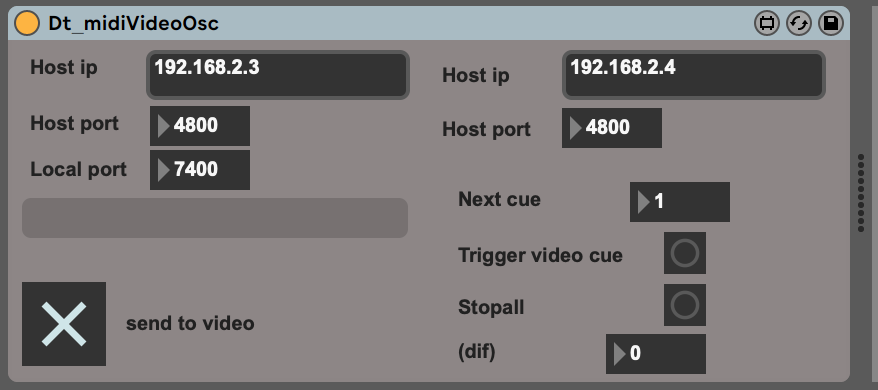
5. Live patch presentation
Shortcuts
Press twice ‘$’ to reset the live session.
Use up and down arrows can be used to select the following scene.
‘enter’ key can be used to trigger the selected scene (master track should be selected).
Main patch
The main patch consists in an Ableton live session ‘De_Tinieblas-concert17’.
From left to right:
- folder ‘inputs’: audio inputs 1-16 from adc 1-16
The inputs are pre-routed to four mono tracks in1 in2 in3 and in4 via the matrix ‘matrixin’.
- ‘matrixin’: The routing is scripted by the name of the clips in the ‘matrixin’ track: a number provided as a name is interpreted as a preset number of the pattrstorage of the matrix.
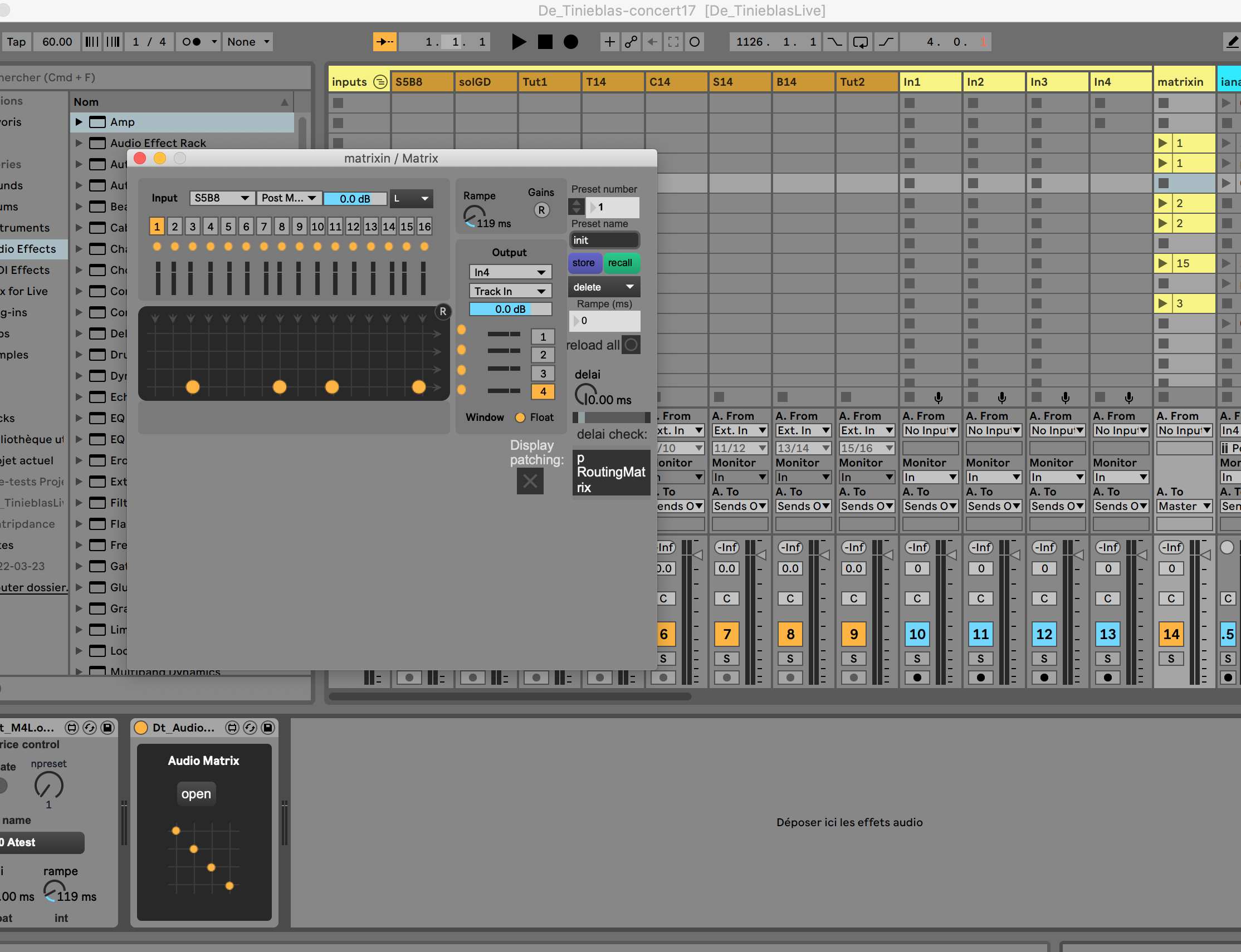
- ‘iana’: In4 is always routed to this track. The track is a Iana synthesis device followed by a reverb device. The name of the clips of the track can either power a ‘rack number_preset number’ or a ramp for a parameter

The syntax is:
‘rack i_preset j’: turn on rack i of the track and recall preset j. A 0 value means turn off all the racks.
‘p_param_value1_time1_value2_time2_value3_time3’: put parameter param to value1 in time1 ms, then put to value2 in time2 ms then put to value3 in time3 ms.
- folder ‘rtime’: there are 5 tracks, 3 for realtime treatments and 2 for spatialization. Each of these tracks have several possible effects device. The name of the clips of the tracks can either power a ‘rack number_preset number’ or a ramp for a parameter.
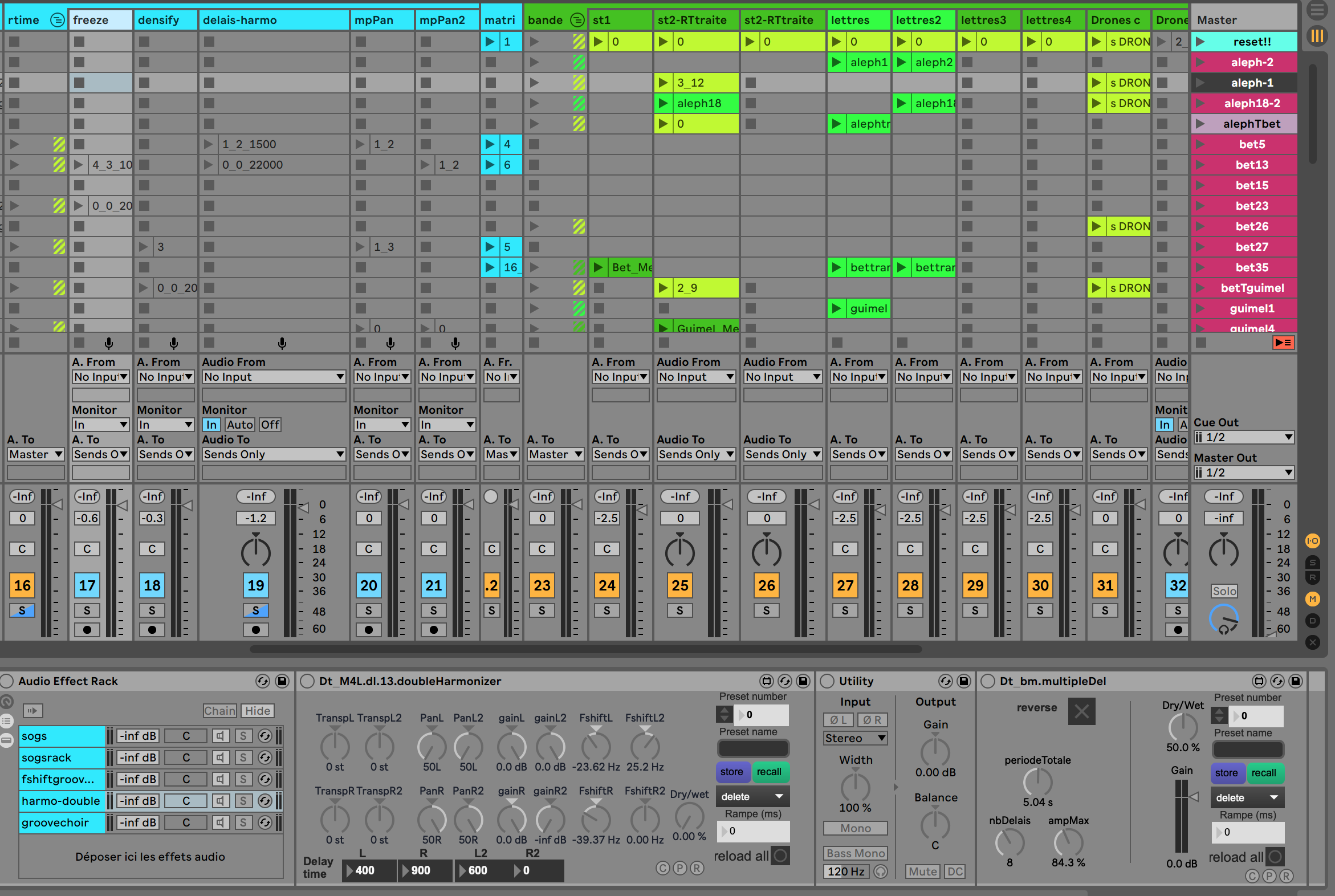
The syntax is:
‘rack i_preset j_ramp k’: turn on rack i of the track and recall preset j then put the gain to 0 dB in k ms. A 0 value means turn off all the racks (by default after setting the gain to -127 in 1000 ms).
‘p_param_value1_time1_value2_time2_value3_time3’: put parameter param to value1 in time1 ms, then put to value2 in time2 ms then put to value3 in time3 ms.
The first track ‘freeze’ contains a rack of 5 devices: sogs (granular synthesis), sogsrack (several parralel granular synthesis), fshifrgroove (delays+frequency shifting), harmo-double (harmonizers+frequency shifting), groovechoir (buffer stretching).
The second track ‘densify’ contains 4 devices: groovechoir, chroma (chromax), eq8 (resonators), and sogs.
The third track ‘delais-harmo’ contains 5 devices: harmo-double, fshiftgroove, sogs, reverblongue, and chroma.
The fourth track ‘mpPan contains 4 devices for spatialisation: pan (simple fixed panning), pan-rot (circular panning), randspat (random gain enveloppes on speakers), panpartout (all speakers opened).
The fifth track ‘mpPan2’ contains 2 devices for spatialisation: pan (simple fixed panning) and panpartout.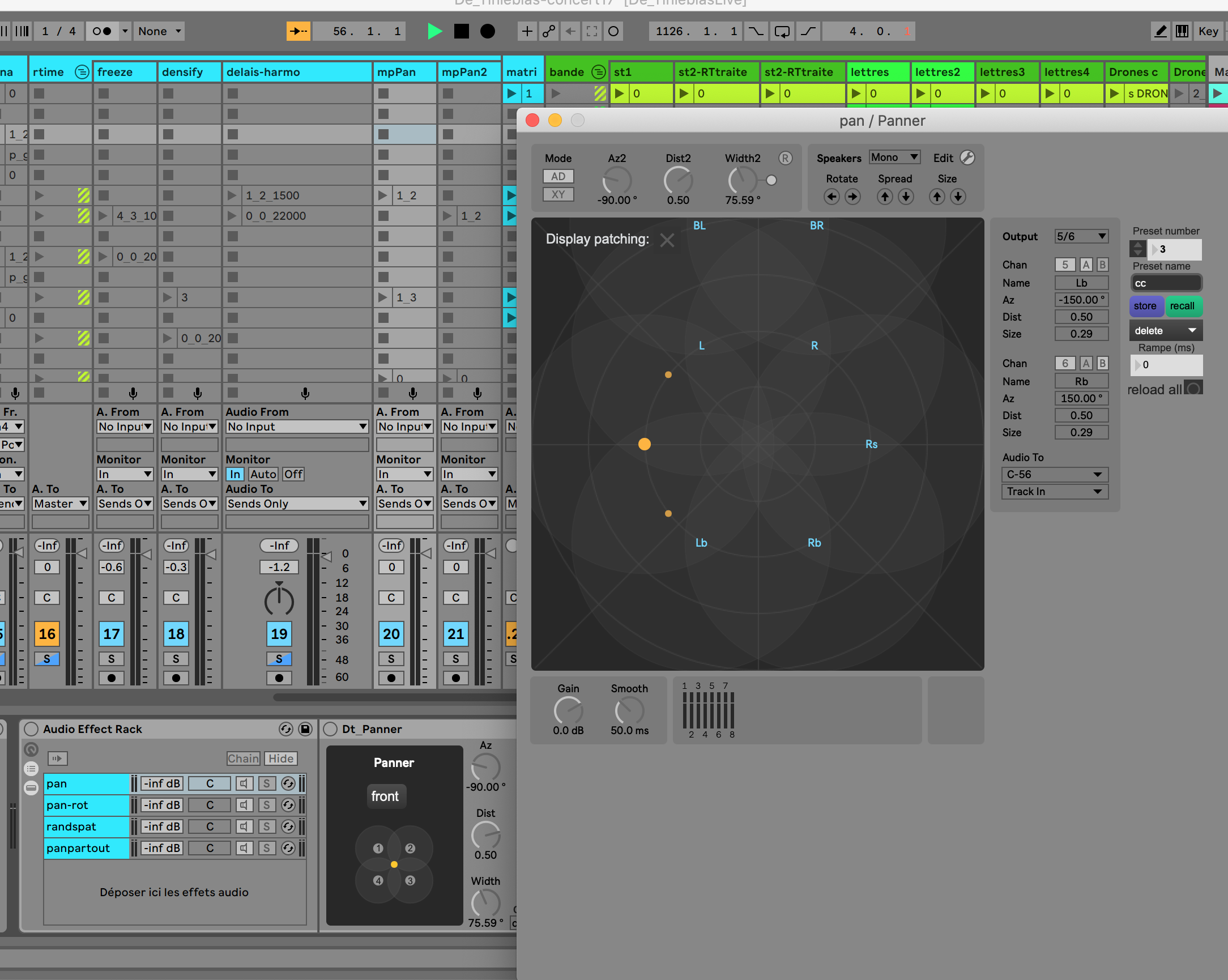
- ‘matrix’: The routing between realtime tratments is done by the matrix track. The routing is scripted by the name of the clips : a number provided as a name is interpreted as a preset number of the pattrstorage of the matrix.
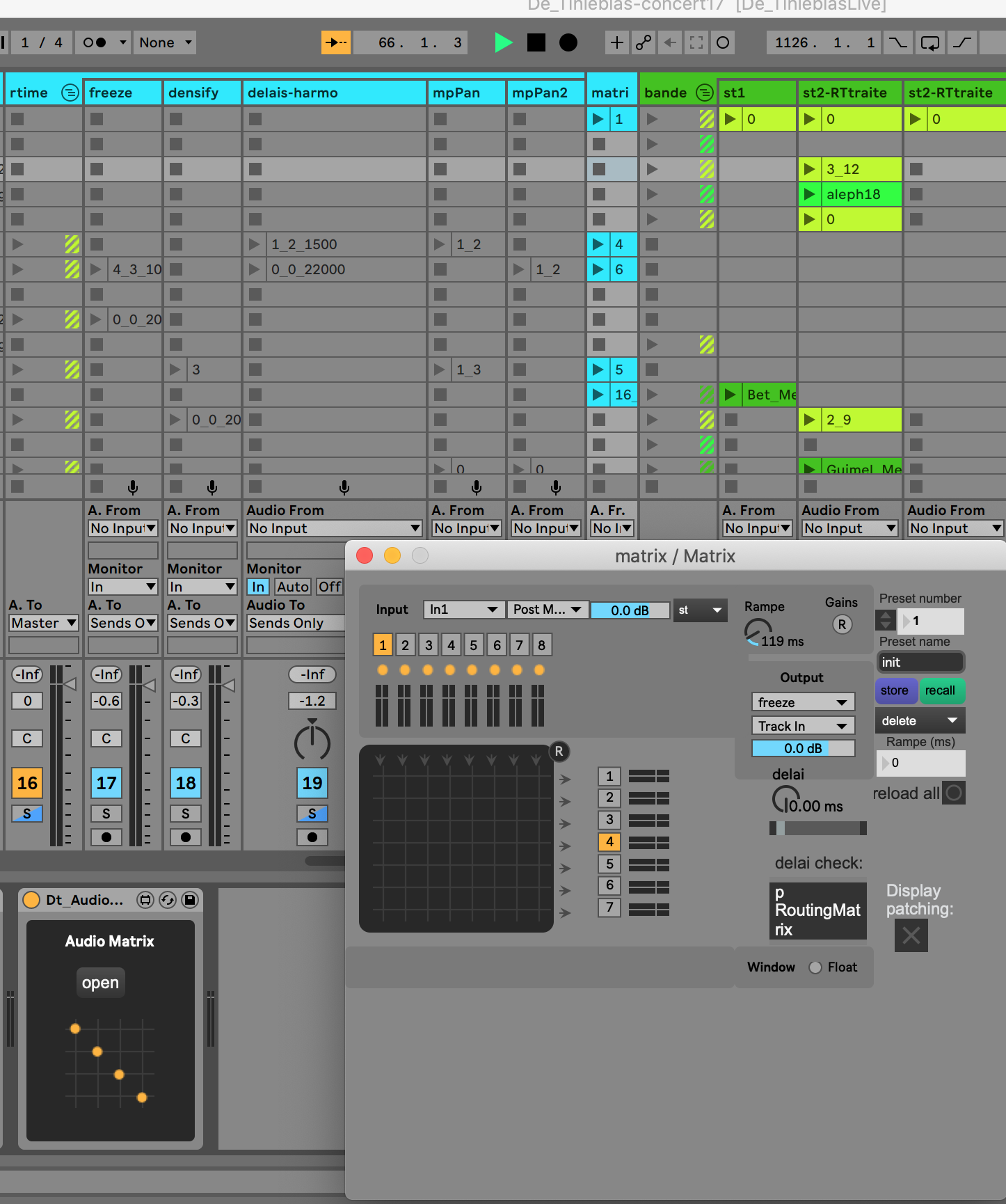
- ‘bande’: this folder contains 11 tracks for soundfiles.
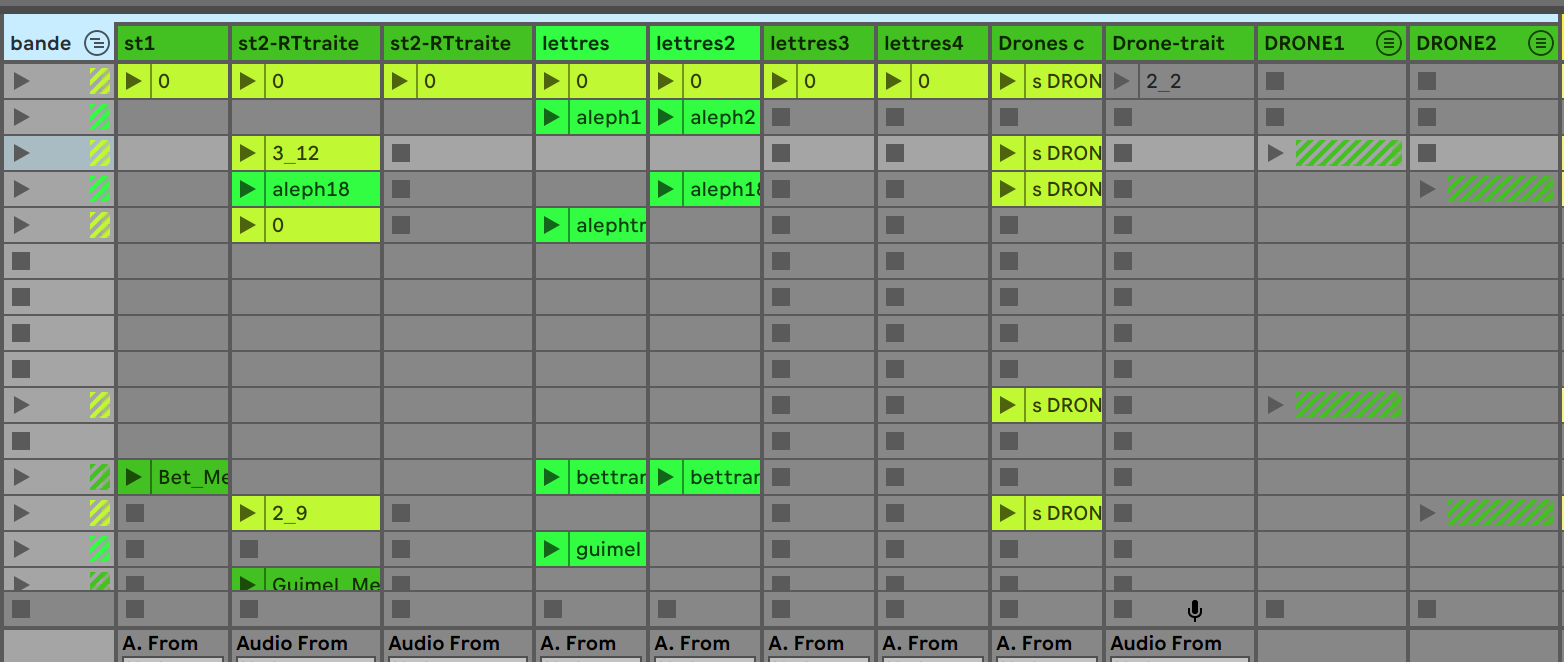
‘st1’ is for stereo soundfiles. The files are sent to some of the return tracks thanks to the enveloppe volume automation of the clips.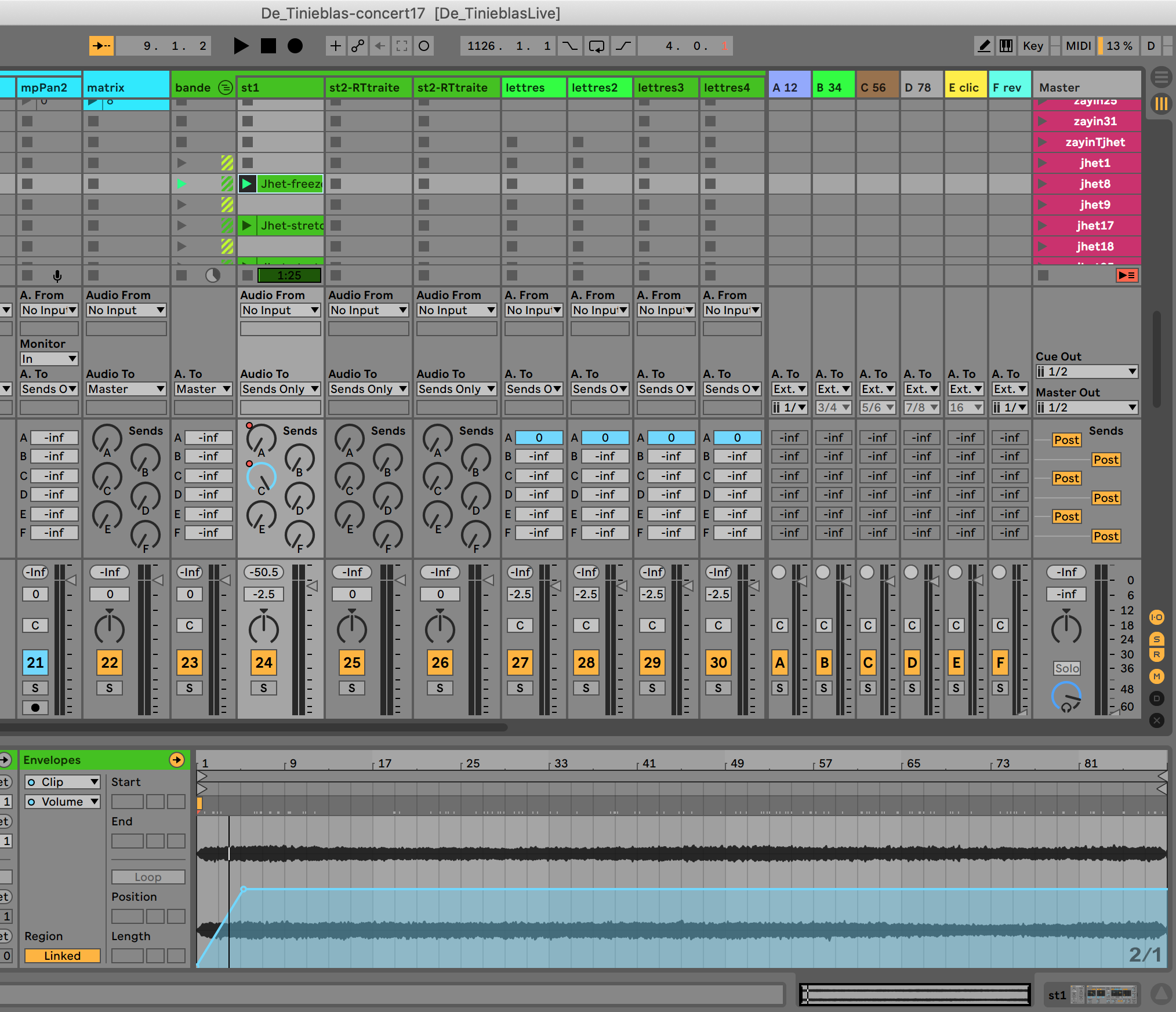
‘st2-RTtraitements’ is a track for soundfiles that can be processed by realtime treatments in their rack device.
Before playing the soundfile, the treatments are powered by playing a clip in the format ‘rack-i_preset-j’ (means power rack-i with preset-j).
‘st2-RTtraitements2’ is the a track similar to ‘st2-RTtraitements’.
‘lettres’ ‘lettres2’ ‘lettres3’ ‘lettres4’ are similar tracks to ‘st1’ with a different reverb.
‘Drones crossfade’, ‘Drone-trait’, ‘DRONE1’ and ‘DRONE2’ are used to play drones sequences. Drones are combinations of stereo files that we can listen to during the piece.
‘Drones crossfade’ is a track for cross-fading between folders DRONE1 and DRONE2.
‘Drone-trait’ is a realtime treatment applied on the active drone.
‘DRONE1’ is a folder of four stereo files constituting a drone.
‘DRONE2’ is a folder of four stereo files constituting a drone.
- ‘cuesVideo’: this track triggers the video sequences using osc. The name of the clips of the track is ‘go video-seq-i’ to trigger video sequence i. ‘stop’ stops and rewind mix16pro.

- ‘trigger’: is a track for trigerring the scenes from a midi external device. Choose the midi input device in the midi input menu of the track.
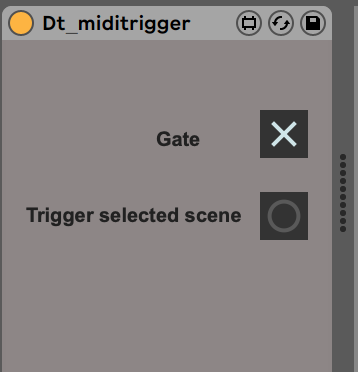
- ‘click’: this track can send an audio mono click track to return E. The name of the clips specify from which bar to start, ie ‘c_bet15’ means start click from bet15. A number i means trigger next scene after i ms. ‘stops’ stops the click.

‘couleurs’: does nothing (;-) but is useful for knowing the colours of the scene even if it is selected.
Returns A B C D correspond to audio outputs 1-2, 3-4, 5-6, and 7-8. Return E is for click. Return F is for reverb.
‘Master’: this track contains the scenes to be triggered. The names of the scenes are the letters followed by the bar number. A color code is used: purple is for scenes triggered by the click-track. Maroon is for scenes to be triggered by hand. Black is for scenes automatically triggered after a certain amount of time.
6. Initialization routine
Video patch
Preload the video files one by one.
Main patch
Test click-track
Reset the patch: press twice key ‘$’
Init the patch: trigger scene ‘reset!!’.
You are ready to play.
7. System calibration and tests
Main patch
Test realtime effects one by one, test spatialisation, and listen to the soundfiles to adjust the levels.
Check the OSC communication with the video computer if video is played.
Check the mixing with the BCF2000.
8. Performance notes
Cues are written in the score ‘CUES-video-Stefano_Gervasoni_-De_tinieblas-_partitura_16.12.20—corr10.02.22’.
All brown scenes are to be triggerred by hand.
Purple scenes are triggerred by click.
Following parts are up to you to decide when triggerring the cues:
- zayinTjhet: wait black light and silence
- jhetTtet: wait black light and silence
- tetTyod: wait black light and silence
Main electronic treatments:
Aleph
bar18 Iana tutti
Bet
bar5 S5
bar13 +basseB8
bar26 tutti
bar27 tutti
Guimel
nothing
Dalet
1-4: groovechoir on tutti
He
1 long reverb tutti
Vav
Iana with tutti (mais serait mieux que les ténors I à IV puis C I à IV puis S I à IV puis B I à IV)
at the end Iana sur tutti
Zayin
tutti1 et tutti2
9 + Iana sur tutti
25 fshift sur tutti
Het
RAS (sfiles)
Tet
34 Iana tutti
Yod
tutti (reverb+Iana)
Caf
tutti
Lamed
soli left on groovechoir
soli right on groovechoir
Iana with tutti
Mem
Iana tutti
Nun
Iana tutti
24 groovechoir: tutti
27 tutti2
© IRCAM

This documentation is licensed under a Creative Commons Attribution-NonCommercial-NoDerivatives 4.0 International License.
Program note
Comme son titre l’indique (en espagnol), *De Tinieblas* est un Office des Ténèbres – en partie du moins, puisque seule est traitée la matinée du Samedi saint, durant laquelle est évoquée la mort du Christ, célébrant la fin des lumières anciennes en même temps que l’arrivée des nouvelles. À l’instar de ses illustres prédécesseurs, Stefano Gervasoni privilégie ici la sobriété de l’écriture chorale, préférant une architecture polyphonique ambitieuse aux finesses du jeu vocal, dont les subtilités se perdent souvent dans la masse, sans parler des traitements électroniques. Des chœurs virtuels viennent de surcroît bien souvent étoffer le contrepoint qui anime le double chœur, dont ils peuvent à l’envi troubler la symétrie. Si De Tinieblas rend un hommage manifeste à l’histoire du genre, la pièce ne reprend toutefois pas le texte liturgique, lui préférant celui que le grand poète espagnol José Angel Valente a tiré des *Lamentations de Jérémie*. La structure, néanmoins, est inchangée : à chaque mouvement correspond une lettre de l’alphabet hébreu – laquelle est chantée, comme dans les *Offices* de la Renaissance et du Baroque, de même que « O Jérusalem », interjection liturgique emblématique des *Lamentations*, qui referme la première et la dernière partie de la pièce. L’énoncé de ces quatorze lettres de l’alphabet hébreu jalonne le discours: quatorze lettres qui sont reprises et retravaillées par l’électronique, de plus en plus retraitées et transformées en matière sonore pure, perdant au passage leur intelligibilité. Elles semblent alors se fondre dans ce qui ressemble à un bourdon sonore, omniprésent d’un bout à l’autre de la pièce. Parfois invisible, parfois un peu plus appuyé, parfois de l’ordre de la gêne sonore, ce bourdon est pour le compositeur comme une « méduse qui plane dans l’espace ». D’abord essentiellement de synthèse et cantonné à l’aigu, il suit une trajectoire générale vers le grave à mesure qu’il s’enrichit des lettres chantées qui défilent. Dès « Bet », il arrive à la tessiture du chœur, auquel il se confronte. Puis il poursuit sa chute. Parvenu à « Nun », le bourdon flirte avec les infrabasses, jusqu’au « O Jérusalem » final, délibérément étiré à l’extrême : les vibrations se ressentent alors physiquement, le sol se met à vibrer – figurant de manière tangible le séisme qui a secoué la Terre au moment de la mort du Christ. « Ce bourdon, dit Gervasoni, c’est comme un écran qui parfois souligne, parfois voile la musique, une métaphore de la mort qui peut aussi bien donner un sens à la vie ou nous empêcher d’en profiter. » Les ténèbres et la mort sont donc ici comme une force d’attraction – dans la musique, comme dans la vidéo que Paolo Pachini a réalisée pour l’accompagner : « Le noir, ditil, n’est pas ici qu’une simple métaphore : il domine une partie des images qui cheminent entre pénombre et obscurité. » Compositeur de formation, le vidéaste Paolo Pachini a travaillé à partir du texte de Valente et de la partition en cours d’écriture de Gervasoni. Diffusée sur un écran classique placé au-dessus du double chœur, la vidéo s’appuie sur l’architecture formelle de la partition. « J’établis des liens entre son et image, parfois mesure par mesure, avec des dialectiques à très court terme, sur lesquelles je veux mettre de l’emphase. Mais il m’arrive aussi de travailler l’oblique, en prenant en considération le continuum temporel de la musique. » La vidéo déroule elle aussi quatorze épisodes, chacun ayant son matériau propre. On peut y retrouver la symbolique mystique liée à la lettre hébraïque correspondante, mais aussi des images apparemment photographiques, des images de synthèse ou des abstractions mêlant synthèse et photo – dans un métissage qui n’est pas sans rappeler le travail de l’électronique réalisé par Stefano Gervasoni et ses RIM, Thomas Goepfer et Benoit Meudic. « Prise de vue réelle et synthèse sont pour moi des canaux parallèles, comme deux manières de regarder un même phénomène, dit Paolo Pachini. » « Le défi était de mettre en musique et en image le noir des ténèbres, conclut Stefano Gervasoni, ce qui est, avouons-le, un peu paradoxal. »Stefano Gervasoni, Paolo Pachini & Jérémie Szpirglas, note de programme du concert ManiFeste du 18 juin 2022 dans la Grande Salle du Centre Pompidou.
Version documentation creation date: 28 septembre 2023 16:17, update date: 25 octobre 2023 10:56